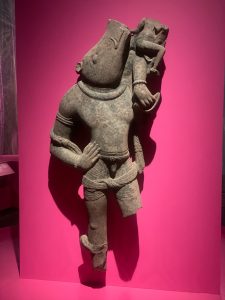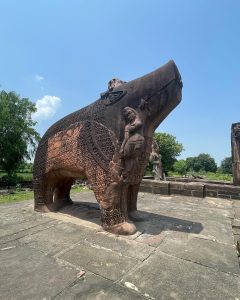LONDON—Let me start my review of an exquisite exhibition with a small gripe: “Ancient India: living traditions” is saddled with a terrible name. The oh-so-obvious juxtaposition of opposites—of “ancient” with “living”—comes straight out of Headline Writing 101. Couldn’t the British Museum, the greatest repository of cultural artifacts in the world, have come up with something a little less clunky, a little more stylish, for a display that seeks to highlight how religious traditions born before the birth of Christ still persist (often unchanged) in present-day India? (That said, let us give thanks that the museum didn’t opt for “Eternal India,” or some such glib orientalist verbiage that would really have hit rock-bottom.)
This is an exhibition of Indian “devotional art” (to use the museum’s phrase), some of it dating back more than 2,000 years. It is accompanied by an impressive hardback catalog (£35), written by Sushma Jansari and Sureshkumar Muthukumaran, the former the curator of the South Asia collections at the British Museum, the latter a lecturer at the Department of History at the National University of Singapore. I counted just under 200 objects (many on loan from the Musée Guimet in Paris and Indian museums) from the three great religions of ancient India: Hinduism, of course, which is the religious mother lode, as well as Jainism and Buddhism, two protestant breakaways from Hinduism, of which only the former, the smaller of the two separatist faiths, remains rooted in India.
Buddhism today is the religion mainly of lands to the east of India (with the exception of Sri Lanka, to the south), to which the faith was exported by Indian kings, missionaries, and traders. The Buddhists in India today are either Tibetan exiles (fleeing ethno-religious persecution by the Chinese in their native land) or 20th-century converts from among the so-called lower castes of Hinduism who have found a refuge in Buddhism from social intolerance. (They’re usually referred to as “neo-Buddhists.”) Although Jainism escaped largely unscathed, the growth of the more doctrinally threatening Buddhism in ancient India was stifled by a vigorous Hindu counterattack (or counter-reformation), which included the cunning strategy of the Hindu religious establishment to co-opt the Buddha himself as a reincarnation (or avatar, in Sanskrit) of Vishnu, the Great Preserver. At a stroke, the founder of Buddhism became a part of the Hindu pantheon.
The geographical focus of the exhibition stretches from modern-day Afghanistan to the easternmost reaches of present India, and includes, as well, objects from the vast Indian cultural diaspora—places like Java, Cambodia, and even Xinjiang. The Scottish popular historian William Dalrymple has written an informative and lively book—The Golden Road, published earlier this year—on how India exported its culture eastward for a thousand years up to around 1200 A.D. That’s how we got Angkor Wat, for instance, and Borobudur.
How thrilling it was for this writer (born a Hindu, and still an intermittent practitioner) to find on display a volcanic-stone Ganesha from distant Java, thought to have been carved sometime between 1000-1200 A.D. The elephant-headed Ganesha is, perhaps, the most popular Hindu deity, widely recognized in the West. The son of Shiva (the god of Destruction), he got his distinctive head after his father lopped off his original pate in anger, making amends by giving his decapitated son the head of the first living thing that passed by—which happened to be an elephant. The Javan statue was presented to the British Museum in 1861 by a donor who collected plants in the Far East for the East India Company in the early 19th century.
The Javan Ganesha, somewhat somber and dark, offers a contrast to a Dancing Ganesha made of sandstone, from 750 A.D. Sculpted in Uttar Pradesh—central India—it is among the first objects a visitor sees as he enters the exhibition. He’s depicted with a bowl of sweets (Ganesha is renowned for his sweet tooth) and is remarkably mobile in his aspect in spite of his pot-belly.
On my visit to the exhibition, an elderly south Indian couple (recognizable as such from the style of the woman’s silk sari) stood reverently before the Dancing Ganesha, the man with his hands pressed together, palms pointing upward. This is the standard Hindu gesture of prayer, and his was made briefly but unabashedly in this public space. Only in India (and, evidently, at exhibitions of Indian religious art abroad) do visitors go into a museum and feel a sense of religious reverence toward the statues and sculptures of the deities on display. When you go to the Prado in Madrid, for instance, the reverence shown by museum-goers before Christian-themed paintings by El Greco, say, or Francisco de Zurbarán, is aesthetic or artistic (maybe even spiritual), but not demonstrably (or demonstratively) religious. At the National Museum in New Delhi, I have seen rustic Indian visitors touch the feet of stone deities on display (not always to the displeasure of the guards), or leave modest offerings of money at a divine statue’s base.
There is, sometimes, a nonsecular sense of awe when a present-day Hindu confronts a figure of Shiva, say, or Lakshmi (the goddess of Wealth) at a museum. These are ancient idols, all conceived for worship and placed originally (for the most part) in temples or at altars. And yet people still revere them in a way that a present-day Egyptian would not revere a statue of Osiris or Anubis. There is something spine-tingling about “seeing your own gods” in a museum.
Most modern Hindus are, of course, able to switch off their reverence, switching to a largely aesthetic mode of observation when faced with a religious object that has been placed in a secular observational context. But a sense of veneration, however diffuse, is always present. I spent an eternity at the exhibition—in truth, maybe about 20 minutes—rooted before a sandstone figure of Varaha, the boar-headed deity who was the third of Vishnu’s 10 temporal incarnations. He holds on his shoulder the goddess Bhu—Bhudevi—the personification of earth, having rescued her from the cosmic ocean where a demon had held her captive. The exhibition’s curator tells us that Varaha’s pose in this “red sandstone sculpture was possibly inspired by the sight of wetland-living wild boars throwing up clods of earth with their tusks, searching for tubers.” The figure on display—nearly five feet tall—is from 400-500 A.D., and from central India.

My fascination with this figure of Varaha has its roots in a spiritual journey I made with my son in September 2023, when the two of us traveled to a godforsaken hamlet in central India called Eran, three-and-a-half hours from the nearest city. Our aim was to see a monumental fifth-century statue of Varaha, believed to be the first entirely theriomorphic—or animal-shaped—depiction of the deity. (On the chest of this Varaha, interestingly, is an inscription attributed to Toramana, the Alchon Hun warlord who conquered the area prior to his defeat.) I was struck by the fact that the Varaha on display at the exhibition—purchased by the British Museum in 1969—was likely from a place not far from Eran. An explanation in the exhibition’s catalog tells us that “the high concentration of monumental Varaha images in central India [is] perhaps related to the densely forested areas whose peoples already held a boar deity in reverence.”

Not all visitors to “Ancient India: living traditions” will react to the objects on display in this intensely personal way. But no one will leave without having experienced a powerful sense of esteem for a culture—a religious belief-system—that has endured for more than two millennia without going defunct, or passing into a state of pure “museum-ness.”
“Ancient India: living traditions” is at the British Museum until October. 19, 2025.
Tunku Varadarajan, a fellow at the American Enterprise Institute, is a writer with the editorial page of the Wall Street Journal.
The post Gallery of the Gods appeared first on .
